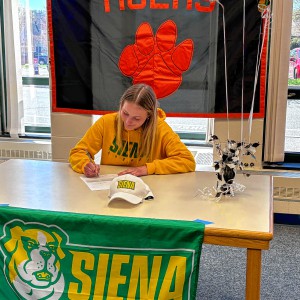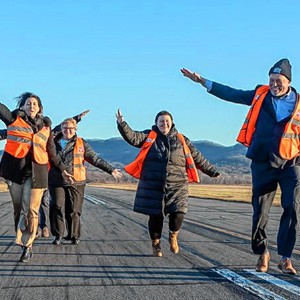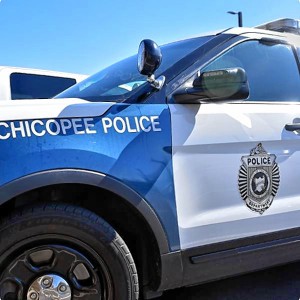Everything you ever wanted to know about Little Free Libraries
| Published: 06-27-2019 12:38 PM |
By Steve Pfarrer
There’s a grand old Victorian house on Crescent Street in Northampton that dates from the 1870s and is full of the kind of architectural details such homes were known for: a steeply-pitched roof, pointed arches and gables and intricate wooden trim.
At the edge of the sweeping front lawn of the property, which slopes down to an antique iron fence along the sidewalk, there’s a tiny replica of sorts of the house, mounted on a wooden post, with two knobs on its front.
An exotic mailbox? A piece of freestanding art? An unorthodox birdhouse, perhaps?
Actually, it’s a Little Free Library — LFL for short — a small book exchange that is part of a national and now an international program to encourage reading, book swapping and community engagement. Open the two doors on the front of the LFL on Crescent St. — the front is painted to mimic the ornate exterior of house — and you’ll find some two dozen books, from children’s titles to adult novels and nonfiction.
You can help yourself: the books are there for anybody. But consider replacing what you took with something from your own collection that you think someone else might want to read. As the logo for the program puts it, “Take a Book — Share a Book.”
“The idea is just to have everybody share what they have,” says Maureen Flannery, who lives at the house and sponsored the installation of the new LFL. “It’s really kind of a community service, and something that can bring people together, to talk about books or just talk in general.”
Article continues after...
Yesterday's Most Read Articles
 South Hadley’s Lauren Marjanski signs National Letter of Intent to play soccer at Siena College
South Hadley’s Lauren Marjanski signs National Letter of Intent to play soccer at Siena College
 LightHouse Holyoke to buy Gateway City Arts, expand offerings and enrollment at alternative school
LightHouse Holyoke to buy Gateway City Arts, expand offerings and enrollment at alternative school
 Treehouse, Big Brothers Big Sisters turn race schedule snafu into positive
Treehouse, Big Brothers Big Sisters turn race schedule snafu into positive
 South Hadley man fatally shot in attempted robbery
South Hadley man fatally shot in attempted robbery
 Granby man admits guilt, gets 2½ years in vehicular homicide
Granby man admits guilt, gets 2½ years in vehicular homicide
 Area briefs: Transhealth to celebrate 3 year; Holyoke to plant tree at museum; Documentary film about reparations focus of Unitarian talk
Area briefs: Transhealth to celebrate 3 year; Holyoke to plant tree at museum; Documentary film about reparations focus of Unitarian talk
On an afternoon in early June, Flannery and some of her neighbors, such as Greg Smith, a contractor who built the mini-library, and Kim Szakalun, were enjoying the sunshine and chatting about the street’s new addition, which had gone up about week earlier. Two young brothers, Langston and Wesley Batchelor, also peered into the structure to see what was available.
“There’s already been a lot of turnover,” said Szakalun. “I took two the other day, so I had to put two back.” She noted that two writers who live on the street — Susanne Dunlap, who writes historical fiction, and children’s author Stephanie Greene — had contributed some of their books to the little library.
“I’ve met some neighbors I’ve never seen before, just being out here restocking the books or checking on them,” added Flannery. And Greg Smith, who walks his dog every day past the LFL, says “It’s a conversation starter — a good place to meet your neighbors and maybe see what they’re reading,”
Familiar scenes are playing out across neighborhoods in other parts of the Valley — and across the world, according to the nonprofit group Little Free Library, located in Hudson, Wisconsin. The organization, started 10 years ago by a Hudson man, Todd Bol, who built a little library in his front yard as a tribute to his late mother, a school teacher, says there are now over 80,000 officially registered LFLs around the world, in all 50 states and 90 countries.
An exact count in the Valley is hard to make, but in this immediate area, there appear to be at least 16 LFLs: eight in Northampton, four in Amherst, two in Williamsburg and one each in Easthampton and South Deerfield.
The process is pretty straightforward. Friends or neighbors or a group of volunteers, at least one of whom ideally has some basic construction experience or knowledge, pool some money and get basic building materials like wood, small doorknobs and hinges, and glass or plexiglass to make a library, which is typically around 21-24 inches tall, about the same dimensions wide, and 18-19 inches deep. This structure is in turn mounted on a solid post of wood, roughly 5 feet high.
For $40, participants can register their LFL with the organization and in turn get a plaque they affix to their structure; the LFL is then added to a global digital map on the group’s website that gives the location and any other relevant details of the structure and its sponsor(s).
Little Free Library (littlefreelibrary.org) sells pre-made libraries of various sizes and in various states of completion (painted vs. unpainted, for example), but in fact there are no particular rules to follow when building your own, and some LFLs have been built to different dimensions and in unusual places, such as within a large tree stump, and with varied stylistic flourishes. The organization’s website has extensive information on all aspects of the process, including instructional videos on building an LFL or funding one on an especially tight budget.
Bruce Simonds of Easthampton, who built one of the earliest LFLs in the Valley, in Easthampton in 2012, says he got interested in doing so after seeing a clip about the program on a TV news program. A retired actuary, Simonds has long done some carpentry and woodworking on the side, and he decided he wanted to add an LFL to Easthampton, but to design something with a little more stylistic panache.
“My feeling is anything that helps promote reading, especially for kids but really for all ages, is a good idea,” he says.
Simonds built his LFL alongside the Manhan Rail Trail where it intersects with Union Street (Route 141) in the downtown part of Easthampton, right near the old train station. His LFL is a miniature version of the station, with a shingled roof, an overhanging porch roof, red-painted plywood walls, tiny framed windows and a few other touches, like two miniature barrels on the station “platform.”
He cut and stained all the tiny shingles for his LFL, whose whole front swings open to reveal the book storage area. “You need to make these things waterproof, so you have to be pretty careful about putting them together,” said Simonds, who spent several months, off and on, building the structure; he continues to make repairs or do maintenance as needed.
Like other “stewards” of LFLs, he stops by about once a week to see if there are enough books on hand and to try and balance the collection between adult and children’s titles. “If it’s 50 percent cookbooks, then I’ll even things out,” he says, adding that book turnover and replenishment generally is pretty good due to the “prime” location of his LFL.
And even though Easthampton’s Emily Williston Library is just a couple blocks away, Simonds doesn’t see the LFL as some sort of competition, or as something that’s superfluous given the library’s nearby location. “I look at it as just another way to give people an opportunity to read,” he says.
Maureen Flannery says much the same. Northampton’s Forbes Library is likely no more than a 10-minute walk from her LFL on Crescent Street. But Flannery, who hired Greg Smith to build the LFL after her two sons gave her money for the project as a Mother’s Day gift, says the small book exchange can simply be a supplement to Forbes; it’s especially nice for younger children, she adds, “as it’s probably simpler for them, and maybe less intimidating, than going into a big library.”
Lisa Downing, Forbes Library director, calls the small book exchanges “a charming community-driven show of support for cultivating access to books and sharing in the love of reading. The books that wind up in LFLs reflect the community members that contribute to them and can serve as a lovely complement to the public library, which develops collections intentionally to serve the needs of everyone in the community.”
The late Todd Bol, who died last fall of cancer, served as the executive director of Little Free Library once it incorporated as a nonprofit in 2012. According to an obituary in the New York Times, he received good feedback from his neighbors after he built the first LFL in his front yard to honor his mother, and other people began to ask him to build additional ones. The concept then began to gain media coverage and spread further through social media.
“I realized there was some kind of magic about it,” Bol told The Washington Post in 2013.
Today, according to the Times, LFLs, in all shapes and sizes, can be found in places as remote as the Yamal Peninsula in Siberia, where one serves reindeer herders and their families, and in urban locales such as New York City subway stations.
There have been occasional snags in the operation, the group says, from incidents of vandalism or bureaucratic standoffs in some communities where LFL builders have run up against strict zoning and housing codes, or cranky neighbors who object to the structures. Those episodes, though, tend to be vastly outweighed by the LFLs that are greeted openly, according to Margret Aldrich, director of media and programming for Little Free Library.
Per its 2018 annual report, Little Free Library generated just under $3 million in revenue last year, primarily from material sales, grants and donations. In turn the group recorded about $2.85 million in expenditures, primarily for its programs, including its “Impact Library Program,” which Aldrich says provides no-cost LFLs to more struggling communities to help increase book access and strengthen neighborhood ties. Over 500 LFLs have been established in such communities in the U.S., Aldrich says.
That’s another good reason to support LFLs and get involved with the program, notes Flannery. “Not only are you encouraging reading in your own neighborhood, you’re helping bring books to places where there may not be that many,” she said. “I just love the whole concept.”
Steve Pfarrer can be reached at spfarrer@gazettenet.com.

 Valley Bounty: Grass-fed animals that feed the grass: Gwydyr Farm in Southampton focuses on ‘restoring the connection between land, food and people’
Valley Bounty: Grass-fed animals that feed the grass: Gwydyr Farm in Southampton focuses on ‘restoring the connection between land, food and people’ Weekly Food Photo Contest: This week’s winner: Mary Chicoine of Easthampton
Weekly Food Photo Contest: This week’s winner: Mary Chicoine of Easthampton  Speaking of Nature: A romantic evening for two birders — To hear the wonderful sounds of the Saw-whet Owl one must go outside at night
Speaking of Nature: A romantic evening for two birders — To hear the wonderful sounds of the Saw-whet Owl one must go outside at night Speaking of Nature: Where have all the birds gone?: They’re there, and here’s a handy tool to keep track of their appearances
Speaking of Nature: Where have all the birds gone?: They’re there, and here’s a handy tool to keep track of their appearances
